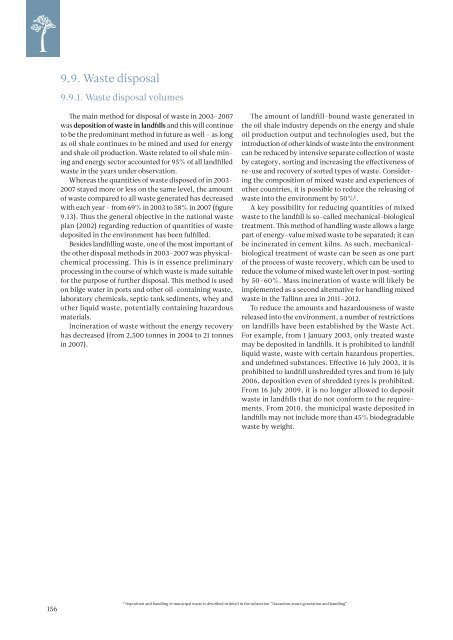ESTONIAN ENVIRONMENTAL REVIEW 2009
ESTONIAN ENVIRONMENTAL REVIEW 2009
ESTONIAN ENVIRONMENTAL REVIEW 2009
Create successful ePaper yourself
Turn your PDF publications into a flip-book with our unique Google optimized e-Paper software.
9.9. Waste disposal<br />
9.9.1. Waste disposal volumes<br />
The main method for disposal of waste in 2003–2007<br />
was deposition of waste in landfills and this will continue<br />
to be the predominant method in future as well – as long<br />
as oil shale continues to be mined and used for energy<br />
and shale oil production. Waste related to oil shale mining<br />
and energy sector accounted for 95% of all landfilled<br />
waste in the years under observation.<br />
Whereas the quantities of waste disposed of in 2003–<br />
2007 stayed more or less on the same level, the amount<br />
of waste compared to all waste generated has decreased<br />
with each year – from 69% in 2003 to 58% in 2007 (figure<br />
9.13). Thus the general objective in the national waste<br />
plan (2002) regarding reduction of quantities of waste<br />
deposited in the environment has been fulfilled.<br />
Besides landfilling waste, one of the most important of<br />
the other disposal methods in 2003–2007 was physicalchemical<br />
processing. This is in essence preliminary<br />
processing in the course of which waste is made suitable<br />
for the purpose of further disposal. This method is used<br />
on bilge water in ports and other oil-containing waste,<br />
laboratory chemicals, septic tank sediments, whey and<br />
other liquid waste, potentially containing hazardous<br />
materials.<br />
Incineration of waste without the energy recovery<br />
has decreased (from 2,500 tonnes in 2004 to 21 tonnes<br />
in 2007).<br />
The amount of landfill-bound waste generated in<br />
the oil shale industry depends on the energy and shale<br />
oil production output and technologies used, but the<br />
introduction of other kinds of waste into the environment<br />
can be reduced by intensive separate collection of waste<br />
by category, sorting and increasing the effectiveness of<br />
re-use and recovery of sorted types of waste. Considering<br />
the composition of mixed waste and experiences of<br />
other countries, it is possible to reduce the releasing of<br />
waste into the environment by 50% E .<br />
A key possibility for reducing quantities of mixed<br />
waste to the landfill is so-called mechanical-biological<br />
treatment. This method of handling waste allows a large<br />
part of energy-value mixed waste to be separated; it can<br />
be incinerated in cement kilns. As such, mechanicalbiological<br />
treatment of waste can be seen as one part<br />
of the process of waste recovery, which can be used to<br />
reduce the volume of mixed waste left over in post-sorting<br />
by 50–60%. Mass incineration of waste will likely be<br />
implemented as a second alternative for handling mixed<br />
waste in the Tallinn area in 2011–2012.<br />
To reduce the amounts and hazardousness of waste<br />
released into the environment, a number of restrictions<br />
on landfills have been established by the Waste Act.<br />
For example, from 1 January 2003, only treated waste<br />
may be deposited in landfills. It is prohibited to landfill<br />
liquid waste, waste with certain hazardous properties,<br />
and undefined substances. Effective 16 July 2003, it is<br />
prohibited to landfill unshredded tyres and from 16 July<br />
2006, deposition even of shredded tyres is prohibited.<br />
From 16 July <strong>2009</strong>, it is no longer allowed to deposit<br />
waste in landfills that do not conform to the requirements.<br />
From 2010, the municipal waste deposited in<br />
landfills may not include more than 45% biodegradable<br />
waste by weight.<br />
156<br />
E<br />
Deposition and handling of municipal waste is described in detail in the subsection “Hazardous waste generation and handling”.

















